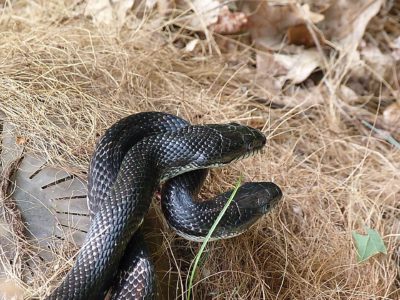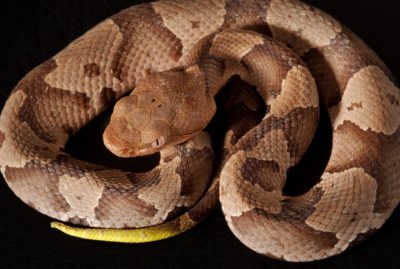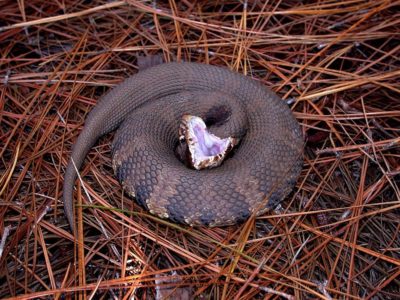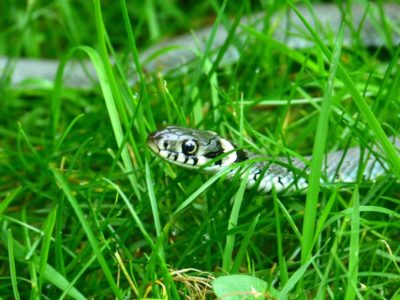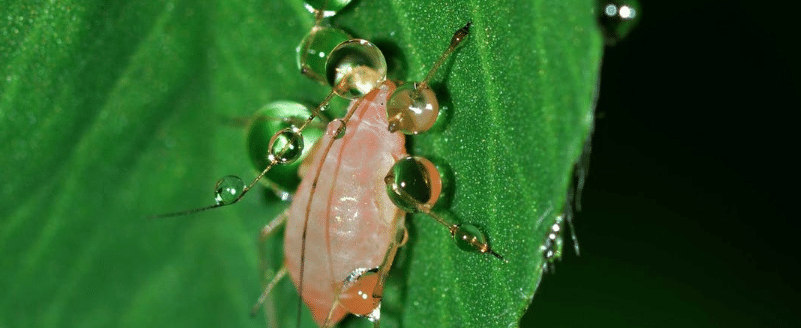What To Do When You Find A Snake In Charlotte
Charlotte is a beautiful city with lush trees and vegetation, but its natural look and feel can also make it an ideal environment for pests like snakes.
Most of the snakes you’ll come across in Charlotte are harmless, but there are a few venomous snakes that you could come across at home or in public areas. Chances are, you’ll come across just one snake at a time, but it’s also possible that you’ll come across a group of snakes (known as a ball, bed, or den of snakes) during the springtime.
In this article, we’ll review:
- How to Properly Identify Venomous and Nonvenomous Snakes
- Copperhead Snakes (venomous)
- Timber Rattlesnakes (venomous)
- Non-venomous Snakes in North Carolina
- What to Do If You’re Bitten by a Snake
- Signs a Pet Has Been Bitten by a Snake
- How Can I Avoid Snakebites at Home?
- What Do You Do if You Find a Snake Outside?
- What Do You Do if You Find a Snake Inside Your Home?
How to Properly Identify Venomous and Nonvenomous Snakes
While North Carolina is home to 37 common snake species, only six of those are venomous, and just three are typically found in the Piedmont area around Charlotte: copperheads, cottonmouths, and rattlesnakes.
There are a lot of myths about identifying venomous snakes that lead to misidentification and fear around all snakes. Some common myths include:
- Head Shape: Many people believe that a triangular head indicates a venomous snake, but in fact, many nonvenomous snakes have naturally triangular heads or can flare their necks in a triangular shape to look threatening.
- Pupil Shape: It’s a common misconception that elliptical pupils are a trait of venomous snakes, but all snakes’ pupils dilate in low light—just like us.
- Rattling Tail: Another common myth is that a rattling tail is a trait only found in venomous snakes, but in fact, many harmless species can rattle their tails to ward of threats.
The best “truth” about identifying venomous snakes is to educate yourself on the types of venomous (and nonvenomous) snakes you might find in our region and to learn how to recognize them.
We recommend using a “whole-body” approach, studying a variety of attributes on a snake, like its color, pattern (e.g. bands or saddles), size, and range.
Many nonvenomous snakes look similar to their venomous cousins as a defense mechanism and to scare off predators, which is why recognizing the details of venomous snakes is so important in learning to identify them.
Venomous Snakes in Charlotte
Copperhead Snakes
Copperheads are the most common venomous snake in North Carolina and account for some 90 percent of venomous snakebites in the state. With its mottled camouflage, bites sometimes occur when a foot or hand is unknowingly placed near these snakes—but more often, these snakebites are a result of attempts to handle or kill copperheads.
Copperheads are found in a variety of habitats but most often in woodlands, especially in thickets, rocky slopes, or, in suburban areas, hiding in junk piles and dilapidated buildings.
While copperheads are mostly nocturnal, especially during summer, they may be active during the day. In winter, they hibernate in sheltered areas and emerge later in spring than most snake species. They prey on small mammals, like rabbits, rats, and mice, as well as other snakes, lizards, frogs, birds, and insects.
How to Identify a Copperhead
- Light brown, tan, or copper in color
- Contrasting darker brown pattern shaped like an hourglass or two Hershey’s Kisses (narrow along its back and wide along its sides)
- Triangular head that is distinct from the neck
- Noticeable dark line between the eye and the rear of the jaw
- Vertical, elliptical pupils
- No pattern on the head, but sometimes two dark spots
- Cream or yellowish belly, sometimes with mottled brown or gray and dark spots on the sides
- Stout body
- When disturbed, vibrate their tails and release musk
Distinguishing Corn Snakes & Copperheads
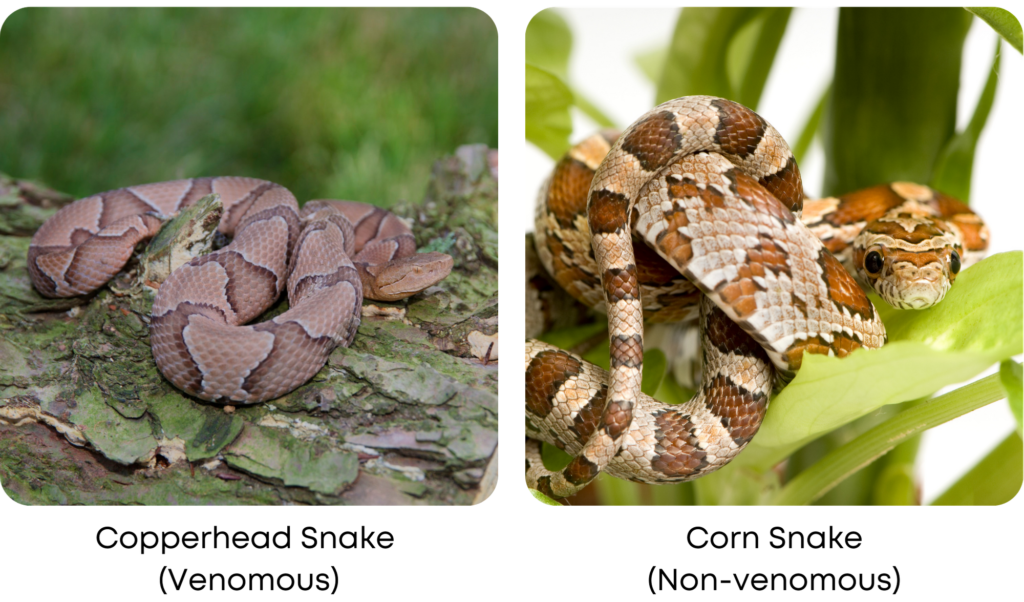
Corn snakes, which are non-venomous, are often mistaken for copperheads because of their similar patterning. But corn snakes are more colorful—usually with more red and orange. While copperheads have the hourglass-shaped pattern, corn snakes have thick “blotches” that don’t narrow at the center. They also have a distinctive black and white checkerboard pattern on their bellies. Finally, corn snakes have a smaller, more narrow head.
Copperhead Bites
Unlike most venomous snakes, copperheads don’t give a warning sign before striking. Their bites are typically not fatal, but they should be taken seriously. Copperhead snake bites are painful and can cause temporary tissue damage around the bite. If you’re bitten by a copperhead, you should immediately seek medical attention.
Timber Rattlesnakes
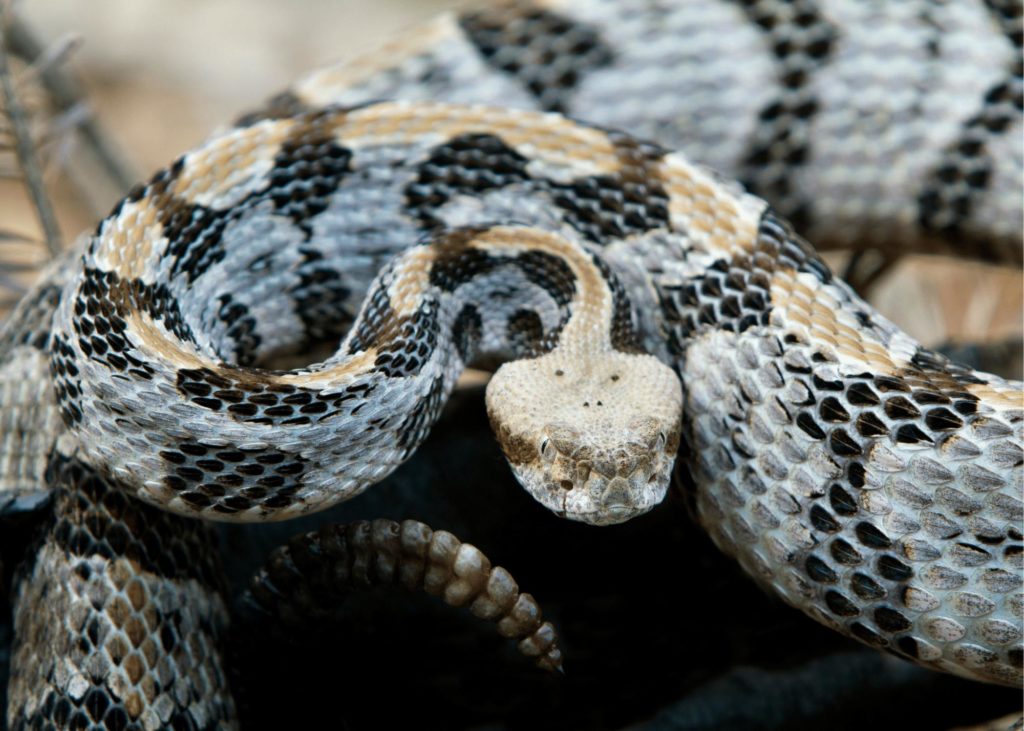
Timber rattlesnakes are large—usually four feet in length—venomous snakes that are common in the wooded mountains and coast, but you’ll occasionally find them around the Charlotte area.
Timber rattlesnakes prefer wooded areas in the mountains and along the coastal plain. They’re rare in the Piedmont because of agriculture and development, but you may still find them in woods around Charlotte. They sneak up on their prey, usually rodents and birds. When they hibernate in late October, they often gather together in large numbers. They emerge (or “egress”) from their dens in mid-April.
How to Identify a Timber Rattlesnake
- Long, heavy bodies usually four feet in length or longer
- Dark crossbands or chevron-pattern across their backs
- In the Piedmont, timber rattlesnakes have a pinkish background color with a brown or orange stripe along the center of their backs
- Black tail (though this can vary)
- Wide head and narrow neck
- Yellow eyes with elliptical pupils
- Vibrate their tails when disturbed
Timber Rattlesnake Bites
While they’re known for their rattle, timber rattlesnakes actually prefer to remain hidden using their camouflage, rather than rattling, or biting. But when they do bite, their venom is very toxic (more so than copperheads) and may be fatal. Timber rattlesnake bites are considered very dangerous, and if you are bitten you should immediately seek medical attention.
Other Venomous Snakes in North Carolina
Eastern Coral Snakes

While not typically found in the Piedmont area, eastern coral snakes can be found in sandy or marshy areas in southeast North Carolina. Eastern coral snakes are small, with an adult length of no more than 30 inches, and are brightly colored with a pattern of black, yellow, and red. They have a black nose with fixed fangs that remain at the front of their mouths. Since these snakes remain underground most of the time, it’s very rare to be bitten by an eastern coral snake in NC.
Cottonmouths
Cottonmouth snakes in the NC area are often known as water moccasins. Cottonmouth snakes have a distinct white mouth that is shown when opening its jaws to devour prey. Cottonmouth snakes have a dark brown coloring with crossbands that fade with age. The average length of a cottonmouth snake in NC is around three to four feet. However, there have been snakes from this species measuring up to seven feet. Cottonmouth snakes are the most aquatic of these species and make their homes near bodies of water. This species is venomous, but with less deadly poison than rattlesnakes.
Non-Venomous Snakes in North Carolina
There are far more nonvenomous snakes in North Carolina that pose no threat to us and are a beneficial element of our ecosystem. Snakes help manage populations of other pests, like rodents, slugs, and insects, and snakes themselves are an important food source for animals like hawks, owls, and raccoons.
North Carolina’s many nonvenomous snakes come in all different shapes and sizes, but it’s worth noting that any snake that is black, mostly black, or solid in color is not venomous.
Some common nonvenomous snakes you might find around Charlotte include:
Brown Snake
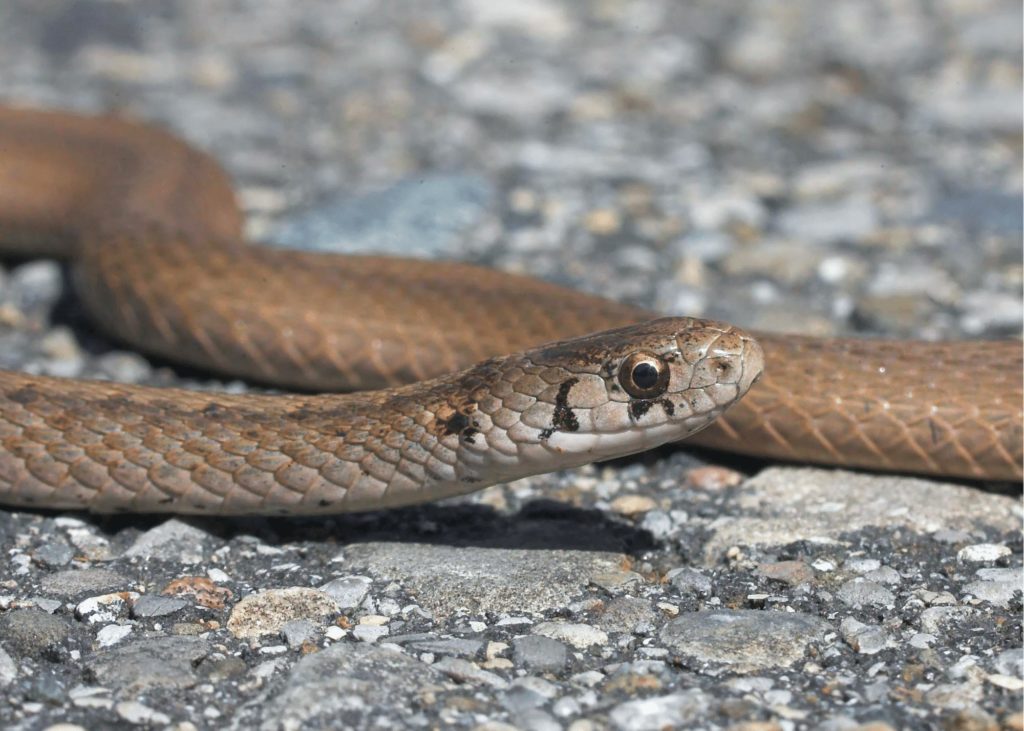
Brown snakes are usually light brown in color with a pale stripe along the middle of their back and a row of small dark spots along both sides. They are quite small (an average of 10 inches). These snakes like to live in flower beds, where they eat pesky slugs, earthworms, and snails. They’re also common in forests across the state.
Worm Snake
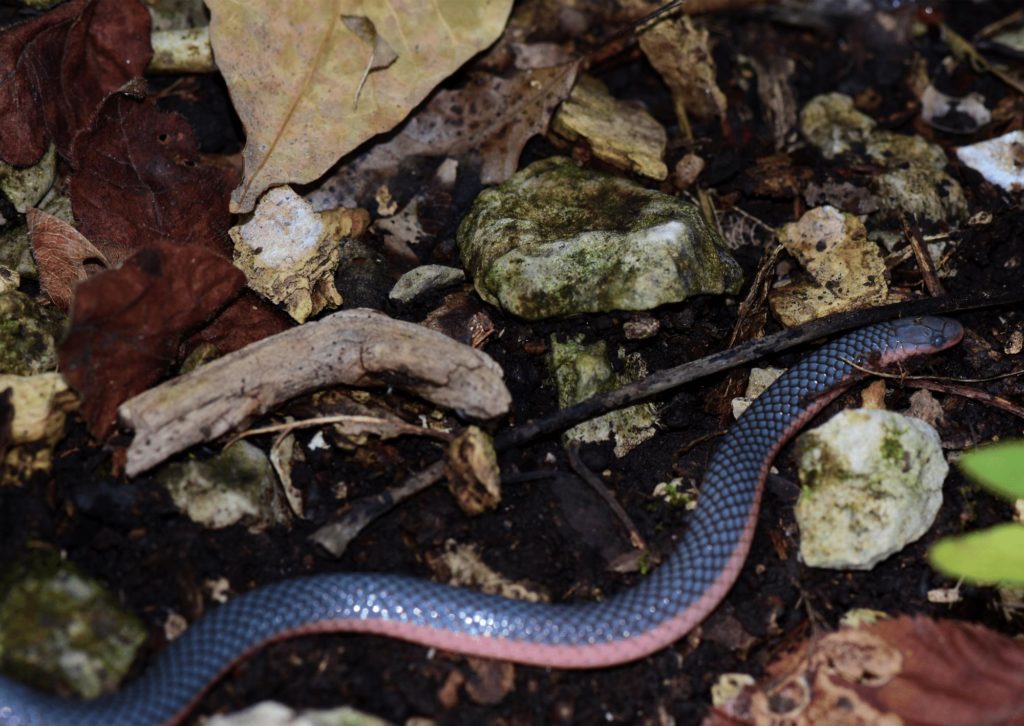
Worm snakes are petite—usually just nine inches long—and shiny. While they have black, gray, or brown backs, they have light belly coloration that can be pink or white and extends up their sides. They’re recognizable by their pointy tails, tiny eyes, and pointed heads. They use their narrow heads to burrow on the hunt for insects and earthworms. They like damp woodlands and rocky hillsides, where they’re active through every season except winter. Worm snakes don’t bite, but if you pick one up they’ll be really wiggly!
Northern Water Snake
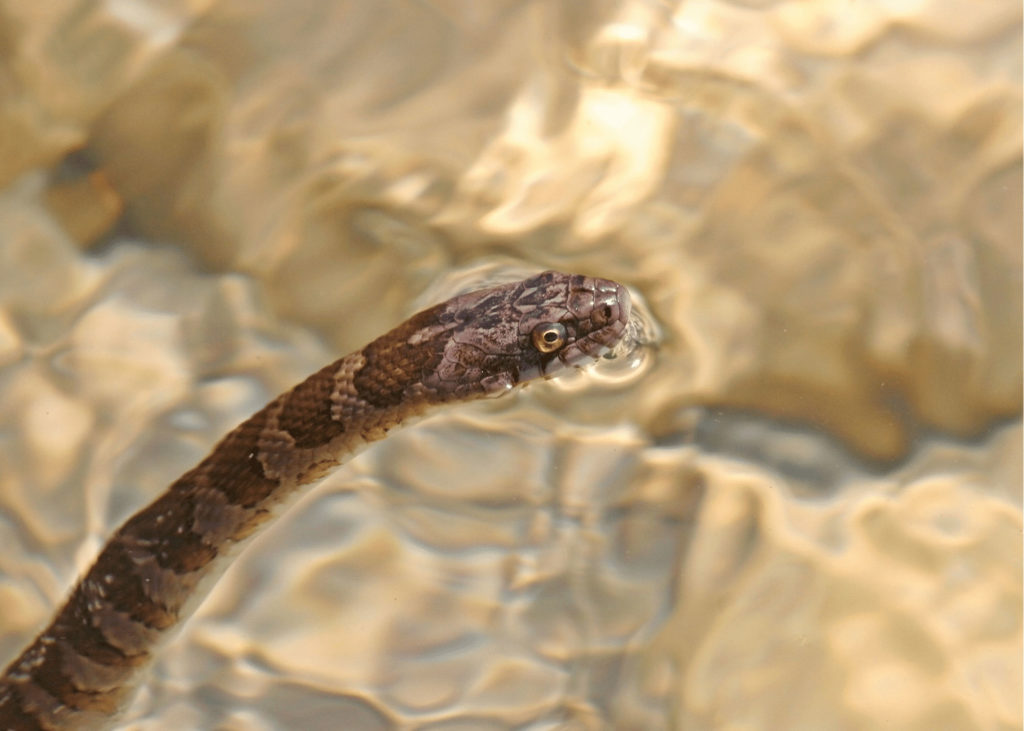
Commonly mistaken for venomous snakes because of the cross banded colorations along the front of their body which break into alternating rows of blotches along the middle and back, northern water snakes are not venomous. They may be gray, red, brown, or black in color but usually darken with age. They’re large—usually two and a half to five feet—and heavy-bodied. Northern water snakes are found throughout North Carolina and are active during both the day and night, when they hunt mostly fish and amphibians.
Black Racer
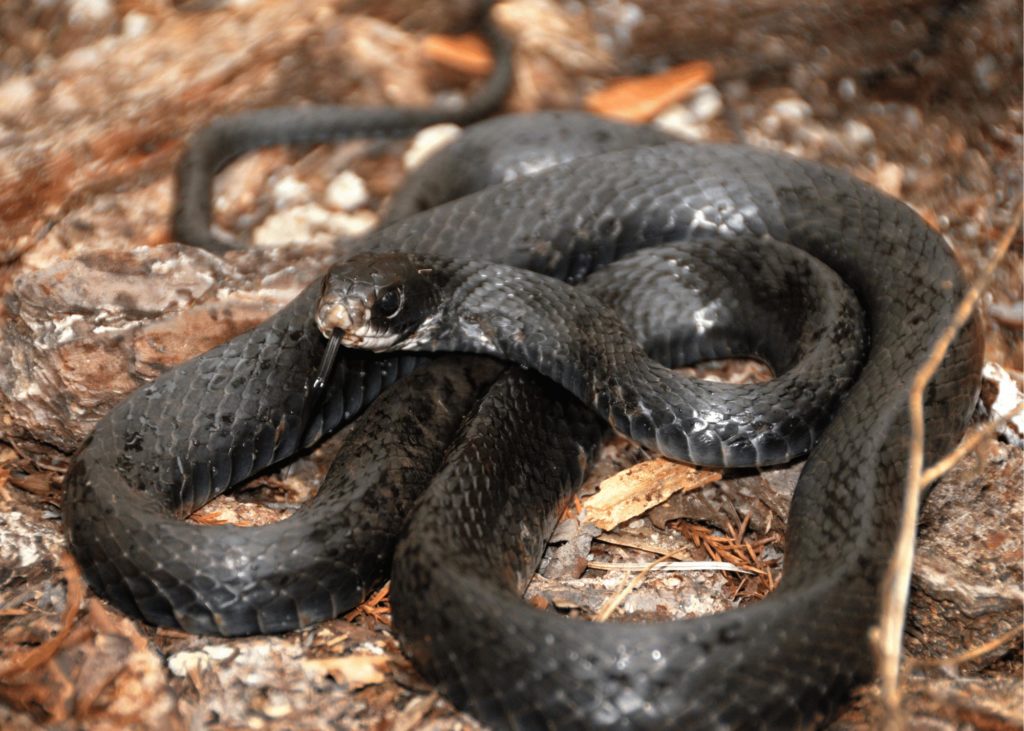
Some of the most common snakes in North Carolina, these long snakes (usually four feet or longer) are known—and named—for their speed. They’re totally black with large eyes and slender bodies. They chase their prey, including rodents, lizards, frogs, and insects, and swallow it whole. Unlike other snakes, they are active only during the daytime and have great vision. Black racers like to bask in the sun and can often be found in open spaces sunning or actively looking for prey.
Corn Snake
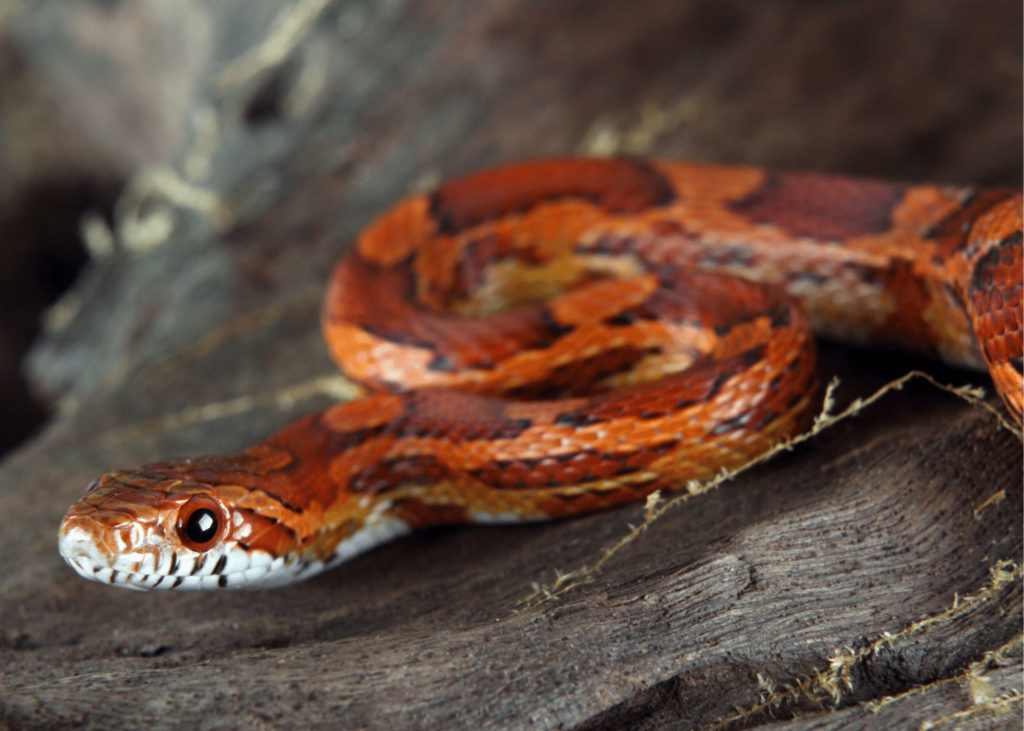
Also often mistaken for copperheads because of their patterns, corn snakes are brighter with orange and red coloring in square blotches along their brown or gray bodies and a black and white checkerboard pattern on their bellies. They are usually found along the edges of fields and clearings, often hiding under logs or rubbish, or hunting for rodents. They get their name from their propensity for sneaking around barns looking for mice and rats, who are there to eat corn and other grains stored within.
Eastern Rat Snake
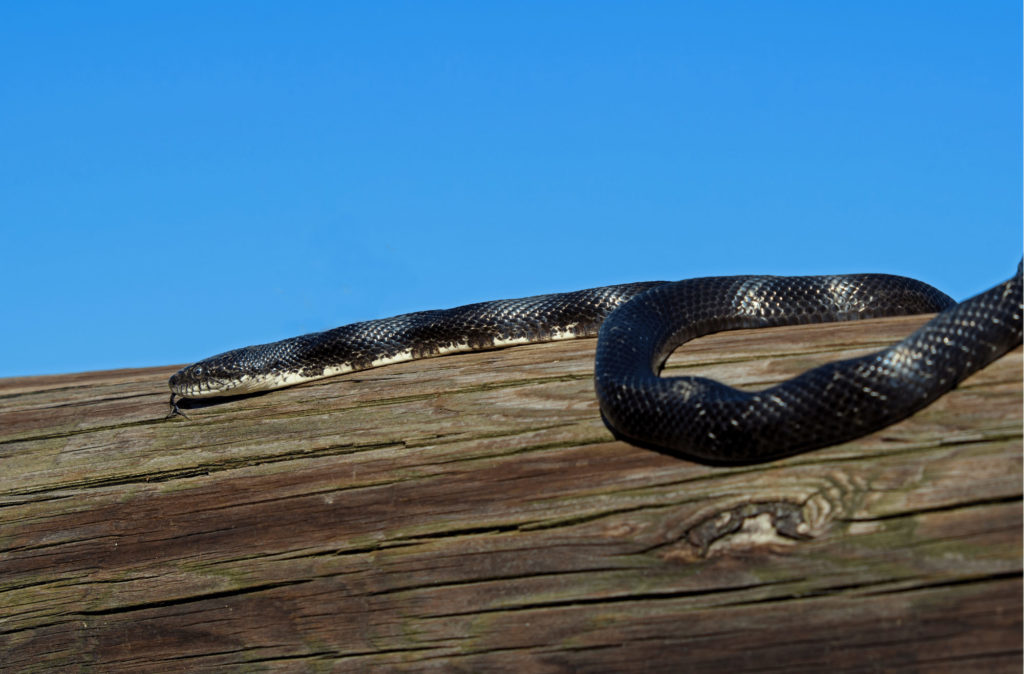
Rat snakes are the most common snakes in most of North Carolina, including the Piedmont. Around Charlotte, rat snakes are usually solid black, but they can also have dark stripes on a yellowish-green body. Their bellies are often black and white checkered. Rat snakes are long (five to eight feet) and heavy-bodied. Rather than being round, their shape is sometimes compared to a loaf of bread—squareish with rounded sides. Rat snakes eat, as the name suggests, rats, as well as mice, birds, and eggs (even chicken eggs!). They’re great climbers, and these snakes are common in suburban areas, where they sneak into chimneys, attics, and basements.
Eastern King Snake
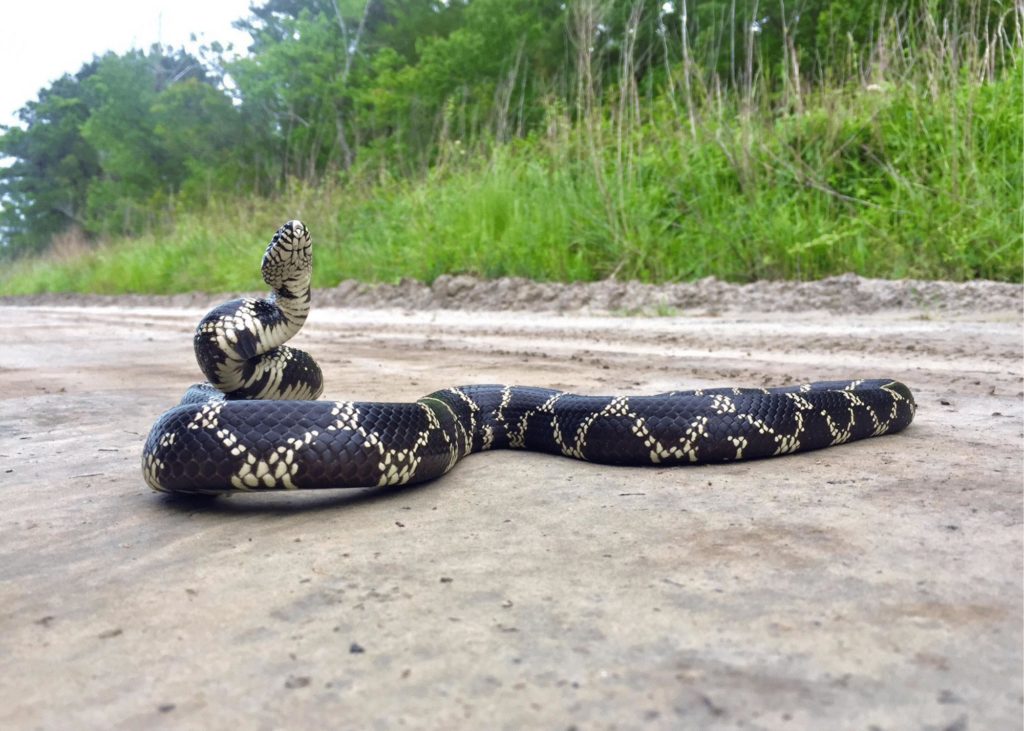
Eastern king snakes are recognizable by their black coloring marked with a thin chain-link pattern in yellow or white. Found across the state of North Carolina, eastern king snakes prey on animals like rodents, frogs, lizards, and snakes—even venomous snakes like rattlesnakes and copperheads because they are immune to their venom! They’re commonly found around farms and suburban areas and like to hide in human junk piles, though they also like to be near water.
What to Do If You’re Bitten by a Snake
Statistics show that bee stings are actually more dangerous than snake bites (in fact, most nonvenomous snakes cannot even bite through clothing). But even if you’re bitten by a Charlotte snake, either venomous or nonvenomous, do not rule out the need for competent medical attention.
If you or someone you know has been bitten by a snake, you should seek out immediate medical assistance. If a snake bite is venomous, long-term exposure could lead to potentially serious or fatal complications. Call Poison Control or 911, and then perform any first aid on the bite.
First Aid for a Snake Bite
- Get away from the snake and don’t attempt to kill it. The snake may bite again if provoked.
- Note any distinct markings as a way to help professionals identify the snake.
- Lie still, preferably on your back. If possible, elevate the wound above heart-level. Stay immobile until medical help arrives.
- Apply an elastic bandage tightly around the wound and secure it in place.
- Gently wash the area with warm, soapy water.
- Remove jewelry or tight clothing near the bite.
- Avoid performing any type of first aid that you didn’t hear about from a trusted source, such as a healthcare professional. Be discerning, since some unreliable sources recommend sucking out the venom or cutting the wound. Both of those actions are dangerous and likely to worsen its condition.
Signs a Pet Has Been Bitten by a Snake
About 80 percent of pets will recover from a snake bite if they’re treated quickly, but doing so requires recognizing the symptoms of a snake bite and immediately seeking medical attention. These symptoms may include:
- An initial cry at the time of the bite
- Sudden weakness and collapse, even if they get up normally after falling
- Trembling or shaking
- Swelling or bruising
- Unsteadiness, limpness, or paralysis
- Excessive drooling or salivation
- Bloody urine
- Diarrhea or vomiting
How can you protect your pets from snakes?
Household pets lack the same instincts as humans to steer clear of snakes. To protect them, you should keep your dog on a short lease while taking walks outside. Stay on marked trails, especially on hikes with areas full of dense grass and large rocks. If your dog reacts when seeing a snake, train it to ignore the reptile by calling it away. When your pet comes to you, reward it with a treat.
In the yard, protect your pets by putting a fence up around your yard. Mow your grass on a regular basis since snakes prefer tall grass. Clean up any debris that could attract rodents, since they are a snake’s main food source.
How Can I Avoid Snakebites at Home?
In general, if you see a snake, leave it alone and it will do the same to you. Most bites occur when inexperienced people seek to handle or kill a snake. The truth is that many of our Charlotte homes bump up against snakes’ natural habitat, so co-existing with snakes (and leaving them undisturbed) is the best option.
However, there are some things you can do to keep snakes at bay.
- Keep the yard mowed
- Remove brush and weeds from around nearby trees as well as the house
- Learn how to “see” uncommon movement
- Avoid dense vegetation
- Wear gloves and long sleeve shirts
- Keep body parts away from areas you cannot see in clearly, i.e. bushes
- Just walk away from a snake if found – don’t try to remove or touch them yourself
- Don’t disturb grouped snakes in beds, dens or balls; rather call for professional Charlotte snake removal
What Do You Do if You Find a Snake Outside?
If you’re on a walk or in your yard and see a snake, don’t attempt to kill it or catch it. Slowly back away from the snake while watching its movements carefully. If a snake is on your property and doesn’t appear to be leaving, contact Carolina Pest Management to discuss safe snake control methods.
In public areas like parks, most snakes are left to their own devices. However, if you notice a snake in a public area and suspect it may be poisonous, contact local wildlife control authorities to report it.
What Do You Do if You Find a Snake Inside Your Home?
Most snakes have a tendency to stay away from populated areas, but snakes have shown up in office buildings, stores, warehouses, and other areas of business.
It’s possible that you may spot a ball, a bed, or a den of snakes too near your home, or perhaps even under or in your home. Or you may see a snake or evidence of its presence inside the house. Remain calm. Never try to herd or trap a snake, especially if you’re unsure of the species.
If you see a live snake, attempt to confine the snake until you’re able to call a wildlife removal specialist like Carolina Pest Management. Non-poisonous snakes in NC are more frequent house guests, but many individuals don’t feel comfortable handling a snake and should entrust the job to professionals.
To prevent snakes from entering your home, you can take extra precautions such as
- Finding and sealing points of entry
- Adding weather stripping to window and door frames
- Eliminating the food source
Since 1939, Carolina Pest Management has been helping homeowners and business owners in the Carolinas remove and manage wildlife and other local pests. When snakes invade your home or land, we have the environmentally-conscious green Charlotte pest control solution. Contact us today to schedule an appointment for Charlotte pest control and wildlife control.

